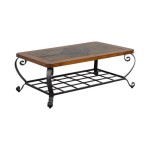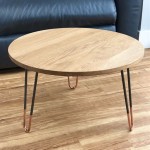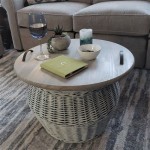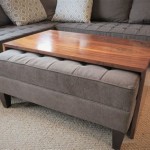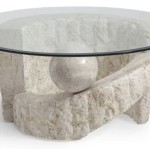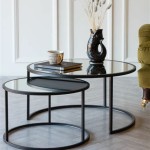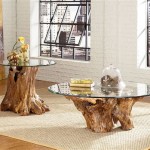What Is The Average Size Of A Round Coffee Table?
Determining the average size of a round coffee table is not a simple task due to the inherent variability in furniture design and the diverse needs of consumers. The "average" size depends heavily on several factors, including the size of the living room, the style of the furniture already present, and the intended function of the coffee table itself. However, by examining common dimensions and considering these influencing factors, a useful understanding of typical round coffee table sizes can be established.
Before delving into specific measurements, it is important to recognize that "average" is a statistical measure representing a central tendency. It doesn't imply that all round coffee tables conform to a single dimension. Instead, it provides a guideline for selecting a coffee table that is appropriately proportioned for a particular setting. Furthermore, manufacturers often offer round coffee tables in a range of sizes to accommodate different spaces and design preferences. This flexibility makes it even more crucial to understand the relationship between room size, furniture arrangement, and the ideal coffee table dimensions.
The general consensus leans toward round coffee tables ranging from 30 to 48 inches in diameter as being common. However, this range provides a rather broad spectrum. To refine this understanding, one must analyze the practical considerations that dictate the appropriateness of a specific diameter. Proximity to seating, accessibility for individuals moving around the room, and the overall visual balance are all paramount when choosing a round coffee table. A table that is too large will obstruct movement and overwhelm the space, while a table that is too small will appear insignificant and may not adequately serve its intended purpose.
The height of a round coffee table is another critical dimension to consider. It typically falls between 16 and 20 inches. This height allows for easy access from a seated position while remaining low enough to maintain a visual flow within the room. As with the diameter, variations in height exist to cater to specific styles and design aesthetics. For instance, a modern, minimalist living room may benefit from a lower coffee table, while a more traditional setting may accommodate a slightly taller one. The height should also complement the height of the surrounding seating, ideally sitting at the same height as the seat cushions or slightly lower.
Ultimately, the ideal size of a round coffee table is dictated by the specific context of the room in which it will reside. Understanding the interplay between various factors like room dimensions, seating arrangements, and personal preferences is key to selecting a coffee table that is both functional and aesthetically pleasing.
Key Point 1: Factors Influencing Round Coffee Table Size
Several crucial factors influence the selection of an appropriate round coffee table size. These extend beyond simple aesthetics and delve into practical considerations of space utilization and functionality. Ignoring these factors can lead to a selection that, although visually appealing in isolation, clashes with the overall harmony and utility of the living area.
Room size is arguably the most significant determinant. A small apartment living room demands a smaller coffee table to avoid overcrowding and maintain ease of movement. Conversely, a large open-plan living space can comfortably accommodate a larger round coffee table, which can serve as a central focal point and anchor the seating arrangement. It's crucial to measure the available floor space meticulously and visualize the intended placement of the coffee table to ensure it doesn't dominate the room or impede traffic flow.
The configuration of seating also plays a vital role. The distance between the sofa or chairs and the coffee table should be comfortable for reaching items placed on the table. A general guideline is to leave approximately 18 inches between the seating and the edge of the coffee table. This spacing allows individuals to comfortably stretch their legs and access the table without feeling cramped. The number of seating units also influences the appropriate coffee table size. A larger seating arrangement necessitates a larger table to provide adequate surface area for all occupants.
The intended use of the coffee table also dictates its appropriate size. If the primary purpose is purely decorative, a smaller table may suffice. However, if the table is intended for practical uses such as holding drinks, snacks, books, or remote controls, a larger surface area is necessary. Consider the typical activities that will take place in the living room and select a coffee table that can adequately accommodate those needs. For example, if the living room is frequently used for entertaining guests, a larger round coffee table that can hold platters of food and beverages is preferable.
The overall style and aesthetic of the room should also be considered. A minimalist living room with sleek modern furniture may benefit from a smaller, simpler round coffee table. A more traditional or eclectic space may accommodate a larger, more ornate coffee table. The coffee table should complement the existing furniture and décor, creating a cohesive and visually appealing atmosphere. Ignoring the existing style can result in a mismatched and disjointed look.
Key Point 2: Diameter vs. Space Considerations
The diameter of a round coffee table is the most prominent dimension in determining its suitability for a specific space. Understanding the relationship between the diameter and the available area is essential to avoid selecting a table that is either too large or too small. This involves careful measurement and a clear understanding of how the coffee table will interact with the surrounding furniture and traffic patterns.
In smaller living rooms, a round coffee table with a diameter of 30 to 36 inches is generally recommended. This size provides adequate surface area for basic necessities without overwhelming the space. It allows for comfortable access from the surrounding seating and minimizes the risk of obstructing movement. A smaller diameter also helps to create a sense of openness and airiness in a confined area.
Medium-sized living rooms can comfortably accommodate a round coffee table with a diameter of 36 to 42 inches. This provides a more generous surface area for holding larger items or accommodating multiple users. It allows for a more substantial presence in the room and can serve as a more prominent focal point. However, it is still important to ensure that there is adequate space between the coffee table and the surrounding seating to allow for comfortable movement.
Larger living rooms can handle round coffee tables with diameters of 42 inches and up. These larger tables provide ample surface area for entertaining, displaying decorative items, or simply providing a more substantial presence in the room. However, it is crucial to ensure that the table is not so large that it dominates the space or impedes traffic flow. The coffee table should be proportionate to the size of the room and the scale of the surrounding furniture.
Beyond the diameter itself, the shape of a round coffee table contributes to its space-saving properties. The absence of sharp corners makes it easier to navigate around the table, reducing the risk of bumping into it. This is particularly beneficial in smaller living rooms where space is at a premium. The rounded shape also creates a softer and more inviting aesthetic, which can enhance the overall ambiance of the room.
It's essential to consider the distance between the coffee table and other furniture pieces. A general rule of thumb is to maintain a distance of at least 18 inches between the coffee table and the sofa or chairs. This allows for comfortable legroom and easy access to the table. It is also important to consider the distance between the coffee table and any walkways or doorways. Ensure that there is ample space for people to move freely around the room without being obstructed by the table.
Key Point 3: Height and Functionality
The height of a round coffee table is just as crucial as its diameter, influencing both comfort and functionality. A coffee table that is too high or too low can be awkward to use and detract from the overall aesthetic of the room. The ideal height should complement the surrounding seating and facilitate comfortable interaction with the table.
The standard height for a round coffee table typically ranges from 16 to 20 inches. This height is generally considered to be comfortable for most people when seated on a sofa or chair. It allows for easy access to items placed on the table without having to strain or reach too far. However, the ideal height may vary depending on the specific height of the surrounding seating.
For a sofa with a standard seat height (typically around 17 to 18 inches), a coffee table height of 16 to 18 inches is generally appropriate. This allows for the coffee table to sit at the same height as the seat cushions or slightly lower. For sofas with higher seat heights, a slightly taller coffee table may be necessary to maintain comfortable access. The goal is to ensure that the coffee table surface is within easy reach from a seated position.
The intended use of the coffee table should also influence the choice of height. If the coffee table is primarily used for placing drinks and snacks, a height that is easy to reach from a seated position is essential. If the coffee table is primarily used for displaying decorative items, a slightly taller height may be preferable to showcase the items more effectively. Consider how the coffee table will be used most frequently and select a height that best suits those needs.
In some cases, a taller coffee table, sometimes referred to as a "cocktail table," may be more appropriate. These tables typically range in height from 20 to 24 inches and are often used in more formal living rooms or in conjunction with higher seating arrangements. A taller coffee table can provide a more elevated surface for serving drinks or displaying decorative items. However, it is important to ensure that the taller table is still proportionate to the size of the room and the scale of the surrounding furniture.
The height of a round coffee table can also influence its perceived visual weight. A lower coffee table can create a sense of openness and airiness in a room, while a taller coffee table can appear more substantial and grounding. Consider the overall aesthetic you are trying to achieve and select a coffee table height that complements that vision. A lower table may be preferable in a minimalist or modern setting, while a taller table may be more appropriate in a traditional or eclectic space.

How To Choose The Right Coffee Table Dimensions Doğtaş

How To Choose The Right Coffee Table Dimensions Doğtaş

How To Choose The Right Coffee Table Dimensions Doğtaş

Ottoman And Coffee Table Size Measurements For Your Space Poly Bark

Diy Coffee Table Easy X Base With Round Top

Coffee Table Size Guide How To Choose The Right One

Coffee Table Size Guide Everything You Need To Know About Dimensions

The Basics Of Coffee Table Styling Shades Blue Interiors

The Ultimate Coffee Table Size Guide Apt2b
:strip_icc()/cdn.cliqueinc.com__cache__posts__268833__how-to-choose-a-coffee-table-268833-1538077854383-main.700x0c-e75faf5929084c2ca523259fd86183c3.jpg?strip=all)
Don T Make This Living Room Coffee Table Mistake
Related Posts

